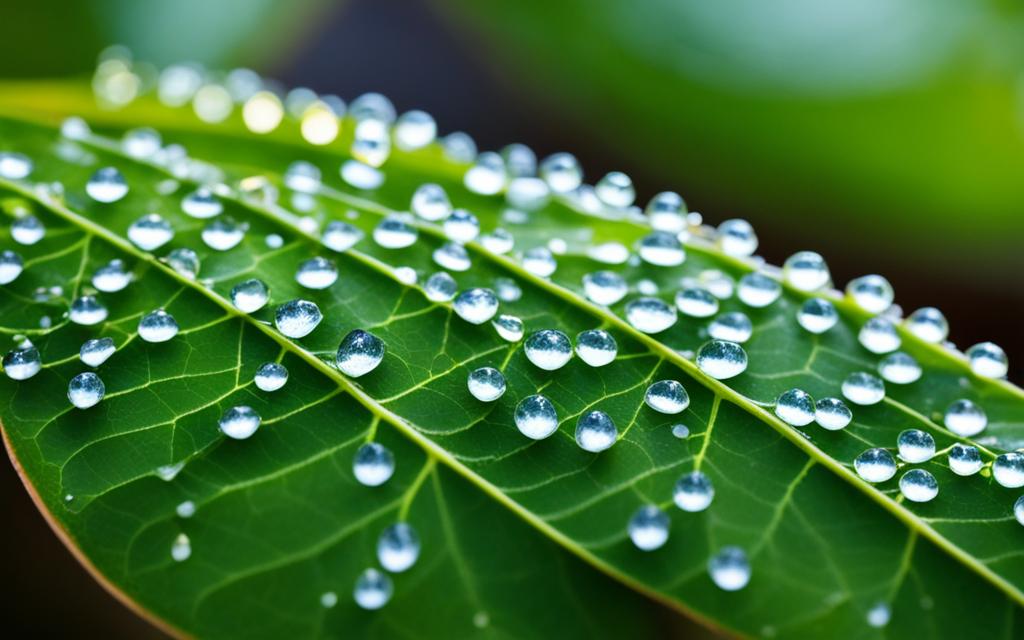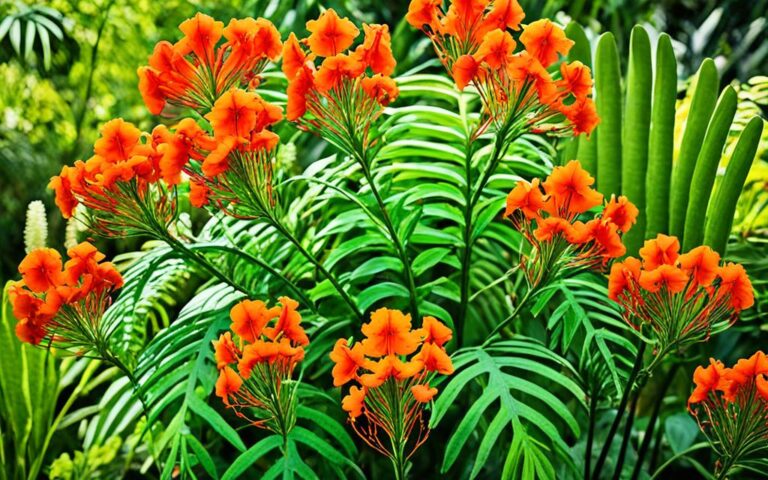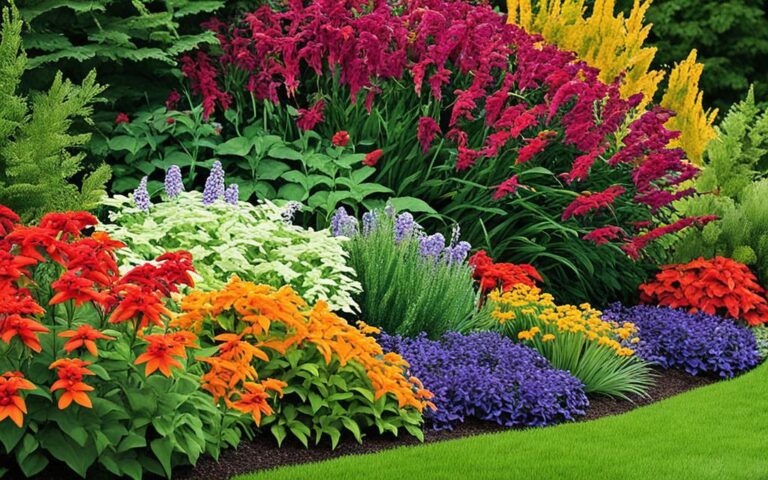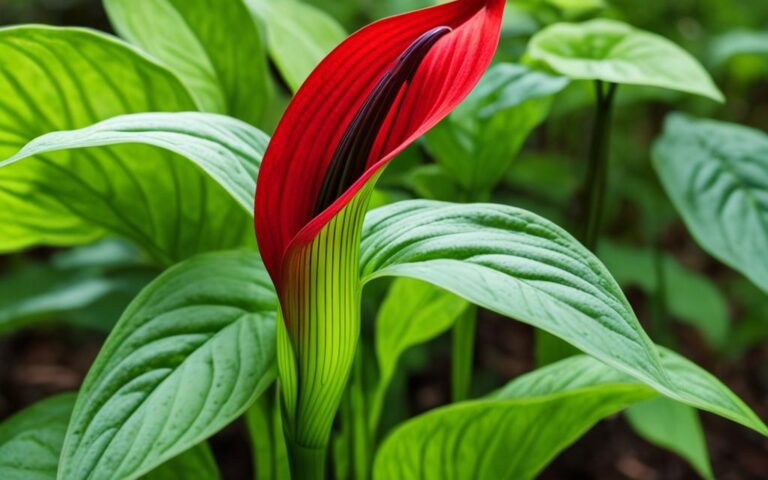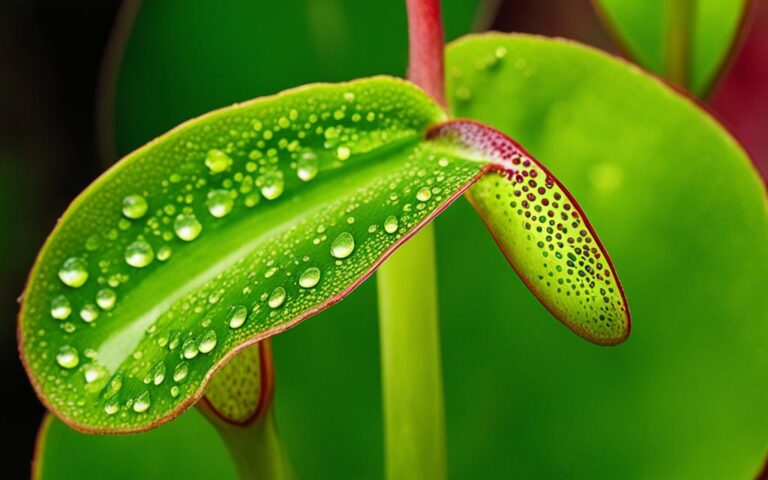Discover the Beauty of Hoya Plants: Care and Tips
Did you know the perfect light for hoya plants is between 1500-2000 foot candles? These houseplants are gaining popularity for their beautiful flowers and sweet smells. Plus, they’re easy to grow from cuttings, great for beginners and experts alike.
With the right care, hoya plants grow well and bloom every year. They come in many types, like ‘Krimson Queen,’ ‘Krinkle 8,’ and ‘Jade.’ These plants can live in different lights and humidities, attracting many plant lovers.
Key Takeaways
- Hoya plants are known for their beautiful, variable flowers and delightful perfumed scents.
- Hoyas are relatively easy to propagate from cuttings, making them a popular choice for plant enthusiasts.
- These houseplants can adapt to a variety of light and humidity conditions, making them suitable for diverse environments.
- Proper care, including watering, fertilizing, and pruning, can help hoya plants thrive and bloom consistently.
- Hoya plants offer a range of cultivars and species, catering to the aesthetic preferences of plant owners.
The Rise of Hoya Plants’ Popularity
In recent years, hoya plants have become more popular in the houseplant world. They are known as “wax plants” or “porcelain flowers”. People love them for their beautiful flowers that look like fancy cake decorations. Plus, it’s easy to grow more hoyas from cuttings, making them a favorite among houseplants.
Reasons for the Surge in Popularity
Many people love hoyas for their unique flowers and smells. Some hoya flowers have a strong scent, while others are sweeter. These plants release their fragrance at night, drawing in moths and beetles in the wild.
Each hoya flower is different, which makes them interesting for plant lovers.
Unique Floral Features and Scents
Hoya plants have beautiful, waxy flowers in colors like white, pink, red, and yellow. Their flowers look like fancy cake decorations, adding to their charm. The different scents of hoya flowers, from sweet to citrusy, make them even more appealing.
“Growing a Hoya plant teaches patience, perseverance, and the joy of witnessing its growth.”
Hoyas are a hit with houseplant fans because of their special features and easy propagation. This has led to their growing popularity in recent years.
Hoya Plants’ Classification and Distribution
Hoya plants belong to the Apocynaceae family, which is close to milkweeds. They share traits like umbel-shaped flowers, sticky sap, and hairy seed pods with common milkweed (Asclepias syriaca). With over 500 species, hoyas show great diversity and spread across the globe.
Classification and Relation to Milkweeds
Hoyas are in the Apocynaceae family, also known as dogbane, and the Asclepiadoideae subfamily. This group includes milkweeds, which have similar flowers and sap. Scientists have long noted the close bond between hoyas and milkweeds.
Geographical Distribution and Diversity
Most hoya species live in subtropical and tropical Asia, especially in the Philippines, Indonesia, Malaysia, and Papua New Guinea. They can also be found in Thailand, China, India, and Australia. By 2015, over 500 hoya names were known, but experts think there are 600-700 species. Many are still being identified and classified.
| Hoya Species and Native Regions |
|---|
|
Hoyas show great diversity and adaptability across Asia. Their wide spread and many species highlight their success in tropical and subtropical regions.
Hoya Plant Varieties and Growth Habits
The genus Hoya has many species and cultivars, each with unique features and growth patterns. The classic Hoya carnosa is known for its waxy, fragrant blooms. Other favorites include ‘Krimson Queen’ and ‘Krimson Princess,’ perfect for every gardener’s taste.
Popular hoya varieties also include the Hoya obovata with its chocolate scent. And the Hoya australis has soft, spade-shaped leaves. With over 200 hoya species and countless hoya cultivars, there are endless options for your garden.
Growth Habits: Climbing, Pendant, and Bushy
These plants show a variety of growth habits. Some are climbers, using tendrils to reach up trellises or walls. Others cascade beautifully, perfect for hanging baskets or shelves.
For a more upright look, there are bushy hoyas. The growth habit of a hoya is key when choosing the right plant. Climbing or pendant varieties fit well in some spaces, while bushy ones are better for others.
| Hoya Variety | Growth Habit | Bloom Characteristics |
|---|---|---|
| Hoya carnosa | Climbing | Waxy, fragrant flowers |
| Hoya obovata | Pendant | Chocolate-scented blooms |
| Hoya australis | Bushy | Soft, spade-shaped leaves |
Anatomy of Hoya Plants
Leaf Morphology and Characteristics
Hoya leaves can be very thin or almost like cacti. Their shape and feel often tell us about where they come from and what they need. Leaves that are thin and large like they belong in the shade and like to stay moist. On the other hand, thick, succulent leaves mean they like bright light and can handle less water.
Stem and Tendril Features
Hoya stems can be woody, green, or even fuzzy. Looking at the stems helps us figure out the best way to grow them. Some hoyas grow roots easily from certain parts of the stem. They also have long tendrils that stick to things, which we should let grow.
Floral Structure and Beauty
Hoya flowers have a special design with three main parts. They grow in clusters that look like umbels. The different types of hoya flowers make them very popular with plant lovers. Hoya carnosa is especially loved for its round flower clusters in pink or white.
| Hoya Leaf Characteristics | Hoya Stem and Tendril Features | Hoya Floral Structure |
|---|---|---|
|
|
|
“The variable nature of hoya flowers, both across species and within the same species, contributes to their visual appeal and popularity among plant enthusiasts.”
Ideal Growing Conditions for Hoya Plants
Light Requirements
Hoyas like bright, indirect light. Some can handle medium light, but direct sun exposure should be limited to avoid damage. It’s key to give them the right amount of hoya light needs and hoya sun exposure indoors.
Temperature and Humidity Needs
Hoyas do well in warm temperatures, between 68-75°F. If it gets too cold, they might stop growing and flowering. They also love high humidity, around 60% or more, since they come from hoya climate requirements in tropical and subtropical areas.
Soil and Watering Guidelines
Hoyas need well-draining, aerated soil to prevent root rot. Adding hoya soil and hoya potting mix like perlite or orchid bark helps with drainage. For hoya watering, let the soil dry out a bit between waterings. Overwatering can harm the plant.
“Hoyas are prized as low-maintenance indoor plants with beautiful blooms.”
Hoya Plant Propagation Methods
Hoya plants are loved for their unique flowers. They are easy to multiply using different methods. Two top ways to grow more hoyas are stem cuttings and air layering.
Hoya Propagation from Stem Cuttings
Propagating hoyas with stem cuttings is simple and effective. You just need a node or two and a leaf for it to root well. Some hoyas can even grow roots without leaves if the stem has chlorophyll. A mix of husk and coir in a 25:75 ratio is great for cuttings. It offers good drainage and air.
- Stem cuttings should be at least 6 inches long with 3-4 leaves for the best results.
- Rooting time can vary widely, from a few weeks to a few months, depending on the hoya variety.
- Coir and husk do not require moving cuttings, unlike other mediums like Leca or Perlite.
- It’s best to underwater hoya cuttings to prevent root rot, and ensure a good soak until water drains through the pot’s drainage holes.
Air Layering Hoya Plants
Air layering is a great way to grow new hoyas from the parent plant. You wrap a stem section in a moist medium like sphagnum moss to help roots form. Once roots are strong, you can cut the stem and pot the new plant.
Hoya plants are easy to grow more of, making them perfect for indoor plant lovers. By learning these propagation methods, gardeners can keep their collections thriving.
Care and Maintenance of Hoya Plants
Keeping your hoya plants healthy and bright needs a gentle touch and sharp eye. It’s important to know how to prune and train them. Also, managing pests and diseases is key to their success.
Pruning and Training Techniques
Don’t cut the long, clinging tendrils of hoyas. These are vital for their growth. Let them climb and attach to supports naturally. Remove dead or damaged parts to keep your plant looking good.
Pest and Disease Management
Hoyas can face issues like stem dieback and leaf drop. These problems often come from bad drainage, too much water, or wrong soil. Watch for pests and fix issues fast to keep your hoya plants healthy.
Fertilization Requirements
Feed your hoyas in spring and summer with a balanced, organic fertilizer. It should be low in salts to protect the roots. Use it often, or with each watering, to help them grow and bloom.
| Hoya Care Tip | Recommendation |
|---|---|
| Light Requirements | Medium to bright, indirect light for optimal growth |
| Watering | Allow soil to dry completely between waterings, reduce frequency in winter |
| Fertilizer | Use a balanced, organic fertilizer during the growing season |
| Repotting | Repot when roots fill the pot, choose a slightly larger container |
| Pruning | Avoid cutting tendrils, remove only dead or damaged growth |
“Hoyas are resilient plants, but with proper care and attention, they can thrive and reward you with their stunning blooms.”
Hoya Plants’ Benefits and Uses
Hoya plants are not just beautiful; they also have many benefits and uses. These plants are easy to care for and offer a lot of advantages. They are perfect for any living space.
Hoya plants clean the air, making them great for homes and offices. The Hindu Rope Hoya and Krimson Queen are top choices for air purification. They also release oxygen at night, improving air quality while you sleep.
Hoya plants can help reduce stress. The Hindu Rope Hoya and Krimson Princess are calming and soothing. They can make a room feel peaceful.
Compact Hoyas like the Carnosa Compacta are easy to care for and help lower stress. They also increase indoor humidity, which is good for both plants and people.
Hoya plants can even help purify water. Early studies show they can remove impurities from water. This makes them a great, eco-friendly choice for any home or office.
Hoya plants are beautiful and offer many practical benefits. They purify the air, reduce stress, and can even purify water. These plants are a valuable addition to any indoor space.
“Hoya plants are a true testament to the beauty and diversity of the natural world, offering a wealth of benefits that make them an invaluable addition to any indoor space.”
Whether you’re an expert or new to Hoya plants, they are a great choice. They are versatile and long-lasting. With the right care, these plants can provide their unique benefits for many years.
Common Hoya Plant Problems and Solutions
Hoya plants are beautiful but can face challenges. Issues like stem dieback, leaf drop, and discoloration may arise. Yet, with careful attention and quick action, many problems can be fixed.
Overwatering is a common issue, causing root rot and fungal diseases. Look for signs like yellow leaves, mushy roots, and stressed plants. To fix this, let the soil dry out a bit between waters and use well-draining potting mix.
- Underwatering can also harm, making leaves wilt and get brown edges. Keep a regular watering schedule and check the soil moisture to prevent this.
- Low humidity can cause leaves to curl and get dry edges. Use misting, a pebble tray with water, or a humid spot to fight this.
- Sunburn can make leaves discolored and shriveled. Move the plant to a shadier spot and filter out harsh sunlight.
Pests like mealybugs, aphids, spider mites, and thrips can harm hoya plants. They cause spots, discoloration, and leaf drop. Remove these bugs by hand or with insecticidal soap spray to keep your plant healthy.
Diseases such as root rot and leaf spot can also happen, often from too much water and high humidity. Improve air flow, cut off sick leaves, and use fungicide to fight these diseases.
By watching closely and fixing problems quickly, you can keep your hoya plants beautiful and healthy. A bit of troubleshooting and care can make a big difference in your plant’s success.
Getting Hoya Plants to Bloom
Hoya plants are known for their beautiful flowers, but making them bloom can be tricky. To get your hoya to flower, you need to create the right conditions. You also need to use special techniques to make it bloom naturally.
Creating Ideal Conditions for Flowering
Hoyas do well in bright, indirect light. It’s important to give your plant enough light to help it bloom. Most hoya types need 2-6 hours of bright, indirect sunlight each day.
Some varieties like Hoya krimson queen, Hoya carnosa, and Hoya kerrii can handle less light. But, they might not bloom as much.
It’s also crucial to keep the soil just right. Water your hoya when the top 1-2 inches of soil feel dry. Cut back on watering in the fall and winter to prevent root rot. A balanced fertilizer with more phosphorus in the growing season can also help with blooming.
Stress Techniques to Induce Blooming
If your hoya won’t bloom, try giving it a bit of stress. This means putting it in brighter light and watering it a bit less for 4-5 weeks. This stress can make the hoya want to bloom and reproduce before it gets too stressed.
But, be careful not to stress your hoya too much. This could hurt the plant. Watch your hoya closely and adjust the stress levels to help it bloom safely.
By giving your hoya the right conditions and using stress techniques carefully, you can boost your chances of seeing its beautiful blooms. With patience and attention, you can help these houseplants show off their stunning flowers.
Hoya Plant Varieties for Collectors
For those who love hoya plants, there’s a world full of unique and beautiful varieties. These rare species and unusual types are perfect for collectors. Each one shows off its own special beauty and charm.
The Hoya linearis stands out with its dramatic, needle-like leaves. The Hoya imbricata has leaves shaped like a turtle shell. And the Hoya lauterbachii is loved for its big, beautiful flowers.
There are many more rare and interesting varieties to discover. The Hoya kentiana has leaves shaped like green beans, edged in dark green and maroon. The Hoya kerrii, also known as the sweetheart plant, has heart-shaped leaves.
Collecting these unique hoya plants is a rewarding hobby. They offer a world full of beauty, from their leaves to their flowers. It’s a chance to explore and enjoy the wonders of nature.
| Rare Hoya Varieties | Distinctive Features |
|---|---|
| Hoya linearis | Dramatic, needle-like leaves |
| Hoya imbricata | Cupped, turtle-shell-like foliage |
| Hoya lauterbachii | Stunning, large-flowered |
| Hoya kentiana | Green bean-shaped leaves rimmed in dark green and maroon |
| Hoya kerrii | Heart-shaped leaves (known as the sweetheart plant) |
Whether you’re an expert or new to hoya plants, exploring their rare species is exciting. Discover the unique varieties that make collecting hoya plants so rewarding.
Hoya Plant Care Tips for Beginners
If you’re new to hoya plants, don’t worry! With some guidance, you can easily care for these beautiful houseplants. This section will give you the key tips for soil, pruning, and propagation to help your hoya flourish.
Soil Choice and Repotting
Choosing the right soil is key for hoya care. Hoyas do well in well-draining potting mix. This mix should include potting soil, succulent and cactus mix, coco chips or orchid bark, and some compost or worm compost on top.
This blend prevents waterlogged roots, which can cause root rot. For repotting, do it in spring or summer when the plant is growing. Hoyas like to be a bit rootbound, which helps them bloom better. When repotting, handle the roots carefully and move the plant to a slightly larger pot to prevent shock.
Pruning and Propagation Guidelines
Pruning your hoya isn’t usually needed, as their tendrils help the plant grow. Let these tendrils climb and attach to supports naturally. If pruning is needed, be careful, as it can delay flowering.
Propagating hoyas from cuttings is easy for beginners. They root well from nodes and leaves. Just cut off a healthy stem, remove lower leaves, and put it in water or a well-draining mix to grow new roots.
“Hoyas are relatively low-maintenance plants, but with a little care and attention, they can thrive and reward you with their stunning, fragrant blooms.”
Hoya Plants as Houseplants
Hoya plants are great for indoor spaces because of their beautiful leaves and flowers. They love bright, indirect light and a warm, humid setting. This makes bathrooms or kitchen windowsills perfect spots for them. They can also grow on shelves or in hanging baskets, showing off their beauty.
Ideal Locations and Environments
For hoya houseplants, it’s important to mimic their natural home. They do well near east- or west-facing windows but avoid direct sunlight. This can burn their leaves. Keeping the right temperature and humidity is also key.
The ideal temperature is 60°-65°F at night and 70°-80°F during the day. This helps them stay healthy.
Maintenance and Care Routine
Looking after hoya indoor plants means sticking to a routine. Check the soil often and keep the humidity right. Water them when the top inch of soil feels dry. This prevents both too much and too little water.
Watering regularly and fertilizing now and then during the growing season keeps them looking great. Following these tips ensures your hoya houseplants stay beautiful and bloom well.
With proper hoya placement and care, these plants can brighten up any room. By watering and caring for them correctly, you’ll enjoy their lush leaves and lovely flowers.
Sun-Stressing Hoya Plants
Recently, a new trend in hoya care has emerged: “sun-stressing.” This method involves giving hoya plants more light than they usually get. This makes their leaves change color, similar to how human skin tans in the sun. As the light increases, the hoya plant starts to show off colors like deep purples and vibrant reds.
This change happens because of natural pigments called anthocyanins. The key to this success is finding the right balance between light and plant health. Too much sun can burn the leaves, so it’s important to increase light slowly and carefully.
It’s important to know how light, anthocyanins, and hoya plants work together. Anthocyanins protect the plant from UV damage and help filter out harmful rays. By controlling factors like fertilizer and temperature, growers can make these pigments show their colors best.
If you love hoya plants or are just getting started, trying sun-stressing can be exciting. With the right balance of light, temperature, and other factors, you can see the beauty of hoya sun stress, hoya light exposure, and hoya color change.
Conclusion
Hoya plants are a great choice for anyone who loves indoor plants. They are beautiful, long-lasting, and not too hard to care for. By knowing what these tropical hoya plants need, you can keep them happy and healthy in your home.
These plants are known for their beautiful flowers and can grow in many ways. They are perfect for both experts and beginners in gardening. This hoya guide has given you all the key info to enjoy growing and taking care of these special houseplants.
Hoya plants are loved by plant lovers all over the world. They are easy to care for and clean the air in your home. By using the advice from this hoya overview, you can make sure your hoya plants do well and add a touch of tropical beauty to your space.
As you keep exploring with hoya plants, remember to appreciate their special traits. Make sure they have the right conditions to grow. With the knowledge from this guide, you’re ready to grow a beautiful hoya collection and enjoy these amazing houseplants.
